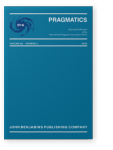The Korean hortative construction revisited
Prototypical and extended functions
This paper revisits the hortative -ca construction in Korean from a usage-based perspective,
examining its functions in natural interactional spoken data The examination of the actual occurrence of -ca
reveals its various functions: -ca indicates that the performer of the focal-event encoded in the utterance may
be 1st person plural subject, i.e., the speaker and other interlocutors; 2nd person, i.e., the addressee(s); 1st person, i.e., the
speaker; and 3rd person. Our findings provide direct evidence for the different degrees of prototypicality among these functions,
which are reflected in their different frequency counts. Furthermore, this study proposes two novel functions of
ca, the accordant imperative (to demand that the addressee agree with the speaker that the addressee perform
the focal-event) and the speaker hortative (to ask the addressee to perform an action so that the speaker him-/herself can perform
the focal-event).
Article outline
- 1.Introduction
- 2.Preliminaries
- 2.1The hortative and related notions
- 2.2Hortatives in Korean grammar
- 3.Data analysis
- 3.1Cohortative -ca: 1st person plural performers of the focal-event
- 3.1.1-Ca in internal monologues
- 3.1.1.1
Idiomatic expression: Eti poca ‘let’s see’
- 3.1.1.2
Idiomatic expressions: -Cako and -cani
- 3.1.2Co-occurrence of explicit references to participants
- 3.1.3
Markers of the conditional: -Chi-ca and -ca-myen
- 3.2Imperative -ca: 2nd person performer(s) of the focal-event
- 3.2.1Polite imperative -ca
- 3.2.2Accordant imperative -ca
- 3.3Speaker hortative -ca: 1st person performer(s) of the focal-event
- 3.4Exhortative -ca: 3rd person performer(s) of the focal-event
- 4.Conclusion
- Notes
-
References
References
Aikhenvald, Alexandra Y.
2016 “
Sentence Types.” In
The Oxford Handbook of Modality and Mood, ed. by
Ian Nuyts and
Johan van der Auwera, 141–165. Oxford: Oxford University Press.

Ammann, Andreas, and Johan van der Auwera
2001 “
Complementizer-Headed Main Clauses for Volitional Moods in the Languages of South-Eastern Europe: A Balkanism?” In
Linguistik Aktuell/Linguistics Today 67, ed. by
Olga Mišeka Tomić, 341–362. Amsterdam: John Benjamins.

Brown, Penelope, and Stephen C. Levinson
1987 Politeness: Some Universals in Language Usage. Cambridge: Cambridge University Press.


Clark, Herbert H.
1996 Using Language. Cambridge: Cambridge University Press.


Doh, Jae Hak
2016 “
On the Strategies and Grammatical Categories that Denote a Concept of ‘Wish’ in Korean.”
Emwunnoncip 781: 361–390.

Du Bois, John W., Schuetze-Coburn, Stephan, Cumming, Susanna, and Paolino Dane
1993 “
Outline of Discourse Transcription.” In
Talking Data: Transcription and Coding in Discourse Research, ed. by
Jane A. Edwards and
Martin D. Lampert, 45–89. Hillsdale, NJ: Lawrence Erlbaum.

Jeon, Byung-yong
1999 Cwungseykwukeuy Emi -Niey Tayhan Yenkwu [
A Study on the Ending -Ni in Middle Korean]. Seoul: Cheongtongkewul.

Kim, Young-cheol
2008 “
A Study on the Discourse Function of ‘JA’ to Discourse Marker in Korean language.”
Kwukemwunhak 451: 5–23.

Koo, Hyun Jung and Seongha Rhee
2008 “
Manipulated Hypotheticality in Conditionals: A Journey in Search of Strength and Diversity.” Paper presented at the 4th New Reflections on Grammaticalization Conference, Catholic University of Leuven, July 16–19, 2008.
Lim, Dong-Hoon
2011 “
Sentence Types and Uses in Korean.”
Journal of Korea Linguistics 601: 323–359.

Mauri, Caterina, and Andrea Sansò
2011 “
How Directive Constructions Emerge: Grammaticalization, Constructionalization, Cooptation.”
Journal of Pragmatics 431: 3489–3521.


Na, Eun-mee
2002 “
The Function of the Korean Utterance-Final Marker ‘-Psita’ with Focus on its Directive Function.”
Icwungenehak 201: 93–110.

Palmer, F. R.
2001 Mood and Modality (2nd edition). Cambridge: Cambridge University Press.


Park, Sook-young
2012 “
Studies on Behaviors Accompanied by Hortative Utterances: A Case Study of ‘-(U)psita, -Ca’.” Paper presented at the 16th Fall Korean Language Culture Education Conference. Yonsei University, Seoul, October 20.
Rhee, Seongha
2016 “
From Quoting to Reporting to Stance-Marking: Rhetorical Strategies and Intersubjectification of Reportative.”
Language Sciences 551: 36–54.


Rhee, Seongha
2017 “
What Happens When the Will Withers: The Case of Hortative in Korean.”
Lingua 189–1901: 51.

Sohn, Ho-Min
1999 The Korean Language. Cambridge: Cambridge University Press.

Traugott, Elizabeth C., and Richard B. Dasher
2002 Regularity in Semantic Change. Cambridge: Cambridge University Press.

Van der Auwera, Johan, Nina Dobrushina, and Valentin Goussev
In press. “
A Semantic Map for Imperative-Hortatives.” In
Points of Comparison in Linguistics: from Morphology to Discourse ed. by
Dominique Willems,
Timothy Colleman and
Bart Defrancq 1 20 Basingstoke Palgrave Macmillan
Van der Auwera, Johan, Nina Dobrushina, and Valentin Goussev
2003 “
Imperative-Hortative systems.” In
World Atlas of Language Structures, ed. by
Matthew Dryer,
Martin Haspelmath,
David Gil, and
Bernard Comrie, 294–297. Oxford: Oxford University Press.

Cited by
Cited by 1 other publications
Kim, Ahrim & Iksoo Kwon
2020.
Hortatives, imperatives, and the directive speech-act continuum: A usage-based approach to the Korean -ca hortative construction.
Lingua 245
► pp. 102928 ff.

This list is based on CrossRef data as of 17 april 2022. Please note that it may not be complete. Sources presented here have been supplied by the respective publishers.
Any errors therein should be reported to them.
